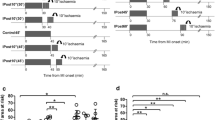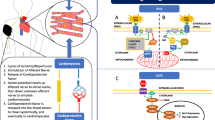Abstract
Objective: Recent studies suggest that ischemic preconditioning (IPC) inhibits myocardial apoptosis after ischemia and reperfusion. This study aimed first, to examine whether short mechanical stretch with acute pressure overload (MPC), which has been shown to reduce infarct size after ischemia/reperfusion, mimics IPC in attenuating myocardial apoptosis and second, to evaluate whether induced cardioprotection involves modulation of the expression of the Bcl-2 family proteins and phosphorylation of prosurvival kinases. Methods and Results: A model of anaesthetized rabbit was used and the preconditioning protocol included one cycle of short ischemia/reperfusion, or short mechanical stretch with acute pressure overload. Preconditioning stimuli were equally effective in reducing the infarct size, determined after 4 h reperfusion. However, IPC but not MPC attenuated myocardial apoptosis. IPC restored the decreased expression of Bcl-2 and Bcl-xL observed in hearts subjected to ischemia and reperfusion only. Bax levels were not different among the groups. ERK1/2 were activated during reperfusion in both IPC and MPC groups. Conclusions: The data provide further evidence that apoptosis and necrosis contribute independently to infarct size after ischemia and reperfusion. Inhibition of the myocardial apoptotic processes by IPC may involve modulation of the expression of anti-apoptotic proteins, Bcl-2 and Bcl-xL. ERK1/2 may be involved in the inhibition of both apoptosis and necrosis.
Similar content being viewed by others
References
Murry CE, Jennings RB, Reimer KA (1986) Preconditioning with ischemia; A delay of lethal cell injury in ischemic myocardium. Circulation 82:1124–136
Murry CE, Jennings RB, Reimer KA (1991) New insights into potential mechanisms of ischemic preconditioning. Circulation 84:442–45
DeFily DV, Chilian WM (1993) Preconditioning protects coronary arteriolar endothelium from ischemia-reperfusion injury. Am J Physiol 265:H700–H706
Richard V, Kaeffer N, Tron C, Thuillez C (1994) Ischemic preconditioning protects against coronary endothelial dysfunction induced by ischemia and reperfusion. Circulation 89:1254–261
Ovize M, Kloner RA, Przyklenk K (1994) Stretch preconditions canine myocardium. Am J Physiol 266:137–46
Gysembergh A, Margonari H, Loufoua J, Ovize A, Andre-Fouet X, Minairen Y, Ovize M (1998) Stretch-induced protection shares a common mechanism with ischemic preconditioning in rabbit heart. Am J Physiol 955–64
Iliodromitis EK, Gaitanaki C, Lazou A, Bofilis E, Karavolias GK, Beis I, Kremastinos DT (2002) Dissociation of stress-activated protein kinase (p38-MAPK and JNKs) phosphorylation from the protective effect of preconditioning in vivo. J Mol Cell Cardiol 34:1019–028
Haunstetter A, Izumo S (1998) Apoptosis: basic mechanisms and implications for cardiovascular disease. Circ Res 82:1111–129
Feuerstein GZ, Young PR (2000) Apoptosis in cardiac diseases: Stress- and mitogen-activated signaling pathways. Cardiovasc Res 45:560–69
Valen G (2003) The basic biology of apoptosis and its implications for cardiac function and viability. Ann Thorac Surg 75:S656–S660
Kajstura J, Cheng W, Reiss K, Szoke E, Cheng W, Olivetti G, Hintze TH, Anversa P (1996) Apoptotic and necrotic cell deaths are independent contributing variables of infarct size in rats. Lab Invest 74:86–07
Bialik S, Greenen DL, Sasson IE, Cheng R, Horner JW, Evans SM, Lord EM, Koch CJ, Kitsis RN (1997) Myocyte apoptosis during acute myocardial infarction in the mouse localizes to hypoxic regions but occurs independently of p53. J Clin Invest 100:1363–372
Walker PR, Sikorska M (1994) Endonuclease activities, chromatin structure, and DNA degradation in apoptosis. Biochem Cell Biol 72:615–23
Gottlieb RA, Gruol DL, Zhu JY, Engler RL (1996) Preconditioning rabbit cardiomyocytes: role of pH, vacuolar proton ATPase, and apoptosis. J Clin Invest 97:2391–398
Fliss H, Gattinger D (1996) Apoptosis in ischemic and reperfused rat myocardium. Circ Res 79:949–56
Maulik N, Yoshida T, Engelman RM, Deaton D, Flack JE, Rousou JA, Das DK (1998) Ischemic preconditioning attenuates apoptotic cell death associated with ischemia/reperfusion. Mol Cell Biochem 186:139–45
Gross A, McDonnell JM, Korsmeyer SJ (1999) BCL-2 family members and the mitochondria in apoptosis. Genes Dev 13:1899–911
Nakamura M, Wang N-P, Zhao Z-Q, Wicox JN, Thourani V, Guyton RA, Vinten- Johansen J (2000) Preconditioning decreases Bax expression, PMN accumulation and apoptosis in reperfused rat heart. Cardiovasc Res 45:661–70
Bartling B, Holtz J, Darmer D (1998) Contribution of myocyte apoptosis to myocardial infarction. Basic Res Cardiol 93:71–4
Kirshenbaum LA, de Moissac D (1997) The bcl-2 gene product prevents programmed cell death of ventricular myocytes. Circulation 96:1580–585
Clerk A, Cole SM, Cullinford TE, Harrison JG, Jormakka M, Valks DM (2003) Regulation of cardiac myocyte cell death. Pharmacol Ther 97:223–61
Zhao ZQ, Nakamura M, Wang NP, Wilcox JN, Shearer S, Ronson RS, Guyton RA, Vinten-Johansen J (2000) Reperfusion induces myocardial apoptotic cell death. Cardiovasc Res 45:651–60
Zhao ZQ, Velez DA, Wang NP, Hewan-Lowe KO, Nakamura M, Guyton RA, Vinten-Johansen J (2001) Progressively developed myocardial apoptotic cell death during late phase of reperfusion. Apoptosis 6:279–90
Scheid MP, Schubert KM, Duronio V (1999) Regulation of Bad Phosphorylation and Association with Bcl-xL by the MAPK/Erk Kinase. J Biol Chem 274:31108–1113
Buckley S, Driscoll B, Barsky L, Weinberg K, Anderson K, Warburton D (1999) ERK activation protects against DNA damage and apoptosis in hyperoxic rat AEC2. Am J Physiol 277:L159–L166
Rapp UR, Rennefahrta U, Troppmair J (2004) Bcl-2 proteins: master switches at the intersection of death signalling and the survival control by Raf kinases. Biochim Biophys Acta 1644:149–58
Herrmann M, Lorenz HM, Voil R, Grunke M, Woith W, Kalden JR (1994) A rapid and simple method for the isolation of apoptotic DNA fragments. Nucleic Acid Res 22:S506–S507
Gottlieb RA, Engler RL (1999) Apoptosis in myocardial ischemia-reperfusion. Ann NY Acad Sci 874:412–26
Krijnen PAJ, Nijmeijer R, Meijer CJLM, Visser CA, Hack CE, Niessen HWM (2002) Apoptosis in myocardial ischaemia and infarction. J Clin Pathol 55:801–11
Van Heerde WL, Robert-Offerman S, Dumont E, Hofstra L, Doevendans PA, Smits JF, Daemen MJ, Reutelingsperger CP (2000) Markers of apoptosis in cardiovascular tissues: focus on Annexin V. Cardiovasc Res 45:549–59
Gottlieb RA, Burleson KO, Kloner RA, Babior BM, Engler RL (1994) Reperfusion injury induces apoptosis in rabbit cardiomyocytes. J Clin Invest 94:1621–628
Freude B, Masters TN, Robicsek F, Fokin A, Kostin S, Zimmermann R, Ullmann C, Lorenz-Meyer S, Schaper J (2000) Apoptosis is initiated by myocardial ischemia and executed during reperfusion. J Mol Cell Cardiol 32:197–08
Piot CA, Padmanaban D, Ursell PC, Sievers RE, Wolfe CL (1997) Ischemic preconditioning decreases apoptosis in rat hearts in vivo. Circulation 96:1598–604
Okubo S, Tanabe Y, Takeda K, Kitayama M, Kanemitsu S, Kukreja RC, Takekoshi N (2004) Ischemic preconditioning and morphine attenuate myocardial apoptosis and infarction after ischemia-reperfusion in rabbits: role of δ-opioid receptor. Am J Physiol 287:H1786–H1791
Maulik N, Engelman RM, Rousou JA, Flack JE III, Deaton D, Das DK (1999) Ischemic preconditioning reduces apoptosis by upregulating anti-death gene Bcl-2. Circulation 100:II369–II375
Maulik N, Sasaki H, Addya S, Das DK (2000) Regulation of cardiomyocyte apoptosis by redox-sensitive transcription factors. FEBS Lett 485:7–2
Hattori R, Hernandez TE, Zhu L (2001) An essential role of the antioxidant gene Bcl-2 in myocardial adaptation to ischemia: an insight with antisense Bcl-2 therapy. Antioxid Redox Signal 3:403–13
Latif N, Khan MA, Birks E (2000) Upregulation of the Bcl-2 family of proteins in end stage heart failure. J Am Coll Cardiol 35:1769–777
Hausenloy DJ, Yellon DM (2004) New directions for protecting the heart against ischaemia-reperfusion injury: targeting the Reperfusion Injury Salvage Kinase (RISK)-pathway. Cardiovascular Res 61:448–60
Hausenloy DJ, Tsang A, Mocanu M, Yellon DM (2005) Ischemic preconditioning protects by activating prosurvival kinases at reperfusion. Am J Physiol 288:H971–H976
Author information
Authors and Affiliations
Corresponding author
Rights and permissions
About this article
Cite this article
Lazou, A., Iliodromitis, E.K., Cieslak, D. et al. Ischemic but not mechanical preconditioning attenuates ischemia/reperfusion induced myocardial apoptosis in anaesthetized rabbits: The role of Bcl-2 family proteins and ERK1/2. Apoptosis 11, 2195–2204 (2006). https://doi.org/10.1007/s10495-006-0292-5
Published:
Issue Date:
DOI: https://doi.org/10.1007/s10495-006-0292-5




